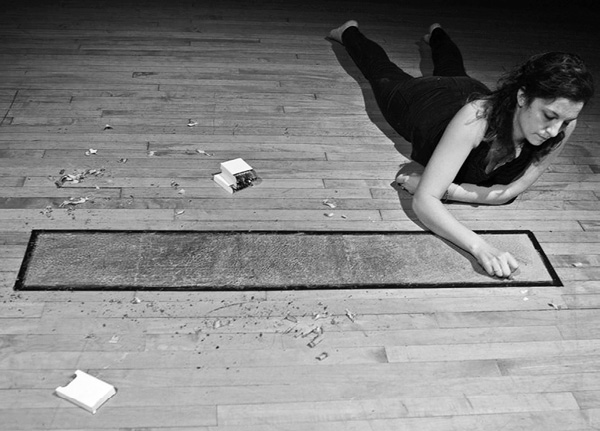
SPENDING TIME
first performed on May 5, 2014
Pozen Center for Interrelated Media, Boston, MA
performed once in 2014
NICOLE CARIMA DUBE
Boston, MA
SPENDING TIME
NICOLE CARIMA DUBE
SPENDING TIME evaluates the physiological effects of aging and the intensity of the daily spectrum of life occurrences. This performance reflected directly on the last half-decade of my career, pondering my time as an emerging artist and simultaneously braiding together my knowledge of the past and the markers of personal importance. In many ways this was an introspective self-portrait.
Durationally this performance spanned three consecutive hours, focusing on my connection to what normally would be the simple act of coloring. Materially I used sandpaper as my coloring surface with the absolute rule that I could only use one color at a time. As a boundary, I didn’t allow myself to choose a new color until I managed to fully retire the crayon—meaning I had to dull the wax down until it had completely dissolved itself into the rough surface of the sandpaper. I used sandpaper and a box of crayons—as light visually wrapped around me—to metaphorically symbolize the poignancy of memory and how we physically relate to current time.
I focused on the difference between natural movement and repetitive movement. Over the course of my performance, my actions—while above all wildly meditative—ranged from relaxing to aggravating to intensely fast and boring to almost painfully slow. The sound was encapsulating and from time to time sounded like white noise.
Aside from photographic documentation, the state of the sandpaper at the end of my performance existed as its own kind of visual performance documentation. It became easy to get lost doing something so repetitive, so in the end having something physical to show was comforting—only leaving behind the ephemera of crayons completely dissolved into the sandpaper, a muddy but beautiful visualization of color and texture.
Ultimately leaving things unanswered, I gave viewers the ability to formulate their own questions and find resolution for themselves.